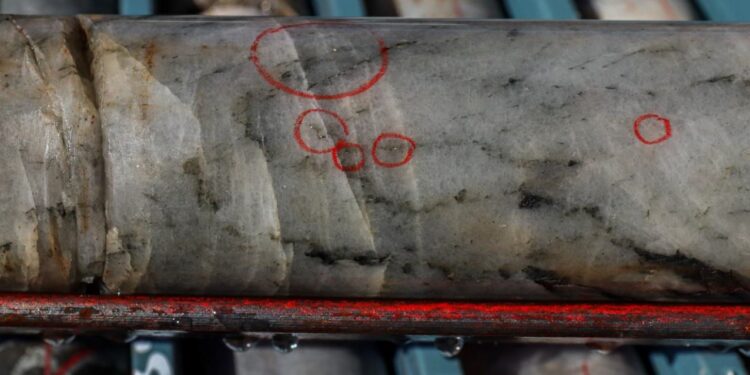Odyssey Gold Limited (ASX:ODY) has sighted visible gold in diamond drilling is underway on the Tuckanarra Project in Western Australia.
Highlights
• Diamond drilling has resumed onsite and will focus on the increasing the geological and structural understanding of the Cable-Bollard Trend.
• Significant quartz veining with visible gold and galena intersected in targeted structure in diamond hole CBDD0010 recently completed at Bollard.
• Hole CBDD0010 is adjacent to hole TCKRC01041 with a result 11m @ 4.6g/t Au previously reported.
• A high-grade shoot is emerging below the existing Bollard Pit. CBDD0010 and TCKRC0104 are the deepest holes drilled, with the shoot open down plunge.
• A high-grade assay result has been received at Cable after additional samples were collected from core not previously sampled: o 1.9m @ 17.0g/t Au from 100m (CBDD0007)
• The new high-grade result in CBDD0007 supports the southerly plunge in the mineralisation to the south of Cable Pit.
• All RC drilling from February and March 2022 are at the lab and results are awaited.
“Diamond drilling is now underway again at our Tuckanarra Project. The intersection of significant visible gold at the targeted position below the Bollard Pit demonstrates gold mineralisation in veining continues to a depth of over 150m,” Managing Director, Matt Briggs, said.
“The existing pit mined in the 1990’s targeted laterite and oxide mineralisation to a maximum of 30m. The structures are open at depth. The RC and diamond drill program underway is continuing to grow the trend to the south.”
Cable-Bollard Trend Background
Previous mining at Cable-Bollard in the 1990’s produced 52.9koz Au at an average grade of 3.4g/t Au from shallow oxide pits. Odyssey has demonstrated the potential to grow the system with mineralisation now extending for over 1.6km of strike and to a vertical depth of over 160m.
The Cable-Bollard Trend comprises multiple parallel mineralised structures made up of banded iron formation (BIF) units, sheared quartz veins in mafic intrusives and metavolcanics, and highly silicified ultramafics resembling BIF’s, with consistent gold mineralisation occasionally interrupted by barren cross cutting felsic dykes.
Bollard Diamond Drilling
The Bollard Pit was mined in 1993 focusing on higher grade areas of shallow laterite and oxide mineralisation.
Although drilling demonstrating multiple zones of gold mineralisation extending below the pit, these were not mined due to the low gold price and limitations of processing at the time. Mining was limited to a maximum of 30m below surface.
Historic holes immediately below the Bollard Pit on the same section being diamond drilled include results of 26m @ 4.2g/t Au from 34m2 (TRC005), 15m @ 1.65g/t Au from 32m2 (TRC0067) and 11m @ 2.2g/t Au from 49m and 8m @ 2.0g/t Au from 1m2 (TRC0066).
An RC hole TCKRC0104 drilled by Odyssey in late 2021 produced results including 6m @ 3.7g/t from 132m3 and 11m @ 4.6g/t Au from 167m. This hole and others on adjacent sections demonstrate mineralisation under the Bollard Pit to 150m below surface and the presence of up to seven parallel structures.
For further information please visit: https://odysseygold.com.au/












